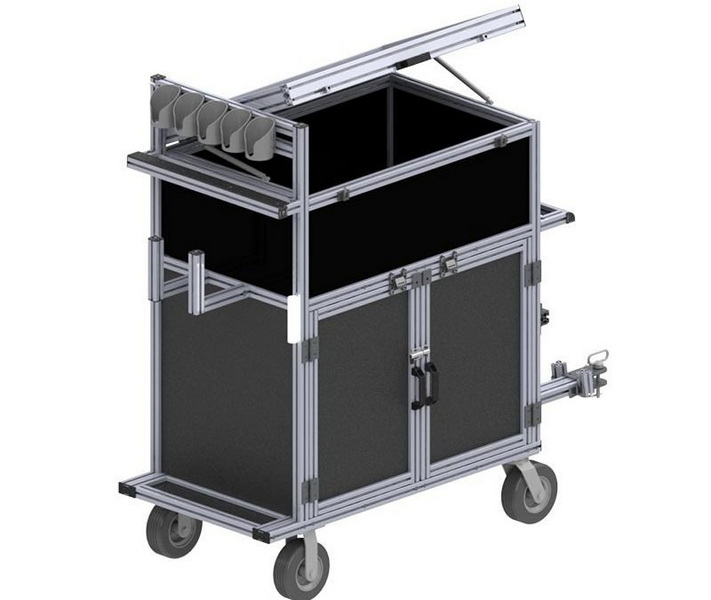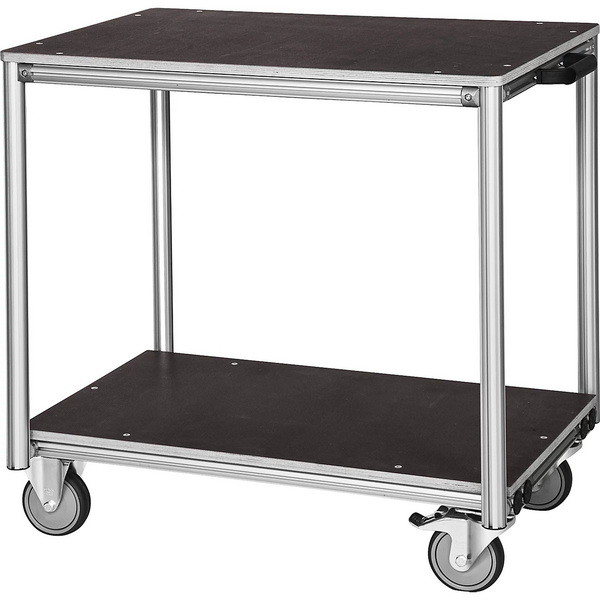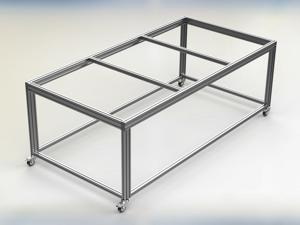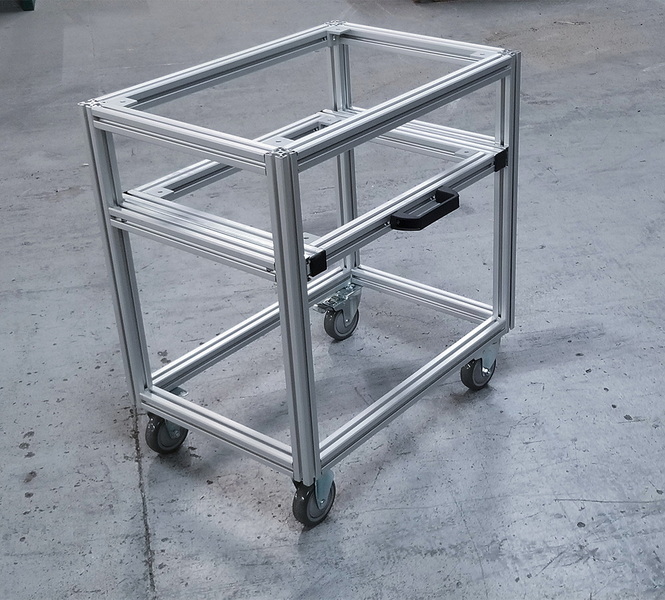Content Menu
● Introduction
● Understanding Aluminum Extrusion Carts
>> The Extrusion Process
● Benefits of Aluminum Extrusion Carts
>> 1. Customizability
>> 2. Durability
>> 3. Mobility
>> 4. Modularity
>> 5. Sustainability
● Choosing the Best Aluminum Extrusion Cart
>> 1. Size and Capacity
>> 2. Configuration
>> 3. Wheel Quality
>> 4. Additional Features
>> 5. Ergonomics
>> 6. Budget
● Popular Aluminum Extrusion Cart Designs
>> 1. Basic Shelf Cart
>> 2. Drawer Cart
>> 3. Combination Cart
>> 4. Mobile Workstation
>> 5. Specialized Carts
● Building Your Own Aluminum Extrusion Cart
>> Steps to Build Your Own Cart:
>> Safety Considerations for DIY Carts
● Maintaining Your Aluminum Extrusion Cart
● Enhancing Your Aluminum Extrusion Cart
>> 1. Tool Holders
>> 2. Cable Management
>> 3. Lighting
>> 4. Power Solutions
>> 5. Label System
>> 6. Specialized Attachments
● Case Studies: Aluminum Extrusion Carts in Action
>> Automotive Workshop
>> Electronics Manufacturing
>> Woodworking Studio
>> Educational Makerspace
● Future Trends in Aluminum Extrusion Carts
● Conclusion
● Frequently Asked Questions
>> 1. What are the weight capacities of typical aluminum extrusion carts?
>> 2. Can I customize an aluminum extrusion cart after purchase?
>> 3. Are aluminum extrusion carts suitable for outdoor use?
>> 4. How do I clean and maintain an aluminum extrusion cart?
>> 5. Can I use aluminum extrusion carts in a cleanroom environment?
Introduction
In today's modern workshop, efficiency and organization are key to productivity. One tool that can significantly enhance your workspace is an aluminum extrusion cart. These versatile carts offer durability, customization, and mobility, making them an invaluable addition to any workshop. In this comprehensive guide, we'll explore the world of aluminum extrusion carts, their benefits, and how to choose the best one for your specific needs.

Understanding Aluminum Extrusion Carts
Aluminum extrusion carts are mobile storage and transport solutions built using aluminum extrusion profiles. These profiles are created by forcing aluminum through a die, resulting in a lightweight yet strong material with a consistent cross-section. The T-slot design of these extrusions allows for easy assembly and customization, making them ideal for constructing carts tailored to various workshop requirements.
The Extrusion Process
The aluminum extrusion process is fascinating and crucial to understanding why these carts are so versatile. Here's a brief overview:
1. Heating: Aluminum billets are heated to around 900°F (482°C).
2. Pressing: The heated aluminum is forced through a die under high pressure.
3. Shaping: The die's shape determines the profile of the extrusion.
4. Cooling: The extruded aluminum is cooled and cut to length.
5. Finishing: The extrusions may undergo additional treatments like anodizing.
This process results in profiles that are strong, lightweight, and have a consistent cross-section, making them perfect for constructing modular structures like carts.
Benefits of Aluminum Extrusion Carts
1. Customizability
One of the primary advantages of aluminum extrusion carts is their high degree of customizability. The T-slot design allows for easy attachment of shelves, drawers, and accessories, enabling you to create a cart that perfectly suits your needs.
2. Durability
Aluminum is known for its strength-to-weight ratio, making these carts both sturdy and lightweight. They can withstand the rigors of daily use in a workshop environment without succumbing to rust or corrosion.
3. Mobility
Equipped with casters, aluminum extrusion carts offer excellent mobility. This allows you to easily move tools, materials, or projects around your workshop, improving efficiency and reducing strain.
4. Modularity
The modular nature of aluminum extrusion systems means you can easily modify or expand your cart as your needs change. This flexibility ensures that your investment remains valuable over time.
5. Sustainability
Aluminum is a highly recyclable material, making these carts an environmentally friendly choice. At the end of their lifecycle, the aluminum components can be recycled and repurposed, reducing waste and environmental impact.
Choosing the Best Aluminum Extrusion Cart
When selecting an aluminum extrusion cart for your workshop, consider the following factors:
1. Size and Capacity
Determine the dimensions and weight capacity that best suit your needs. Consider both the available space in your workshop and the items you plan to store or transport on the cart.
2. Configuration
Think about the layout that would be most beneficial for your work. Do you need multiple shelves, drawers, or a combination of both? Some carts offer adjustable shelving, allowing you to customize the spacing to accommodate various item sizes.
3. Wheel Quality
The type and quality of wheels can significantly impact the cart's functionality. Look for carts with high-quality casters that can handle the weight of your items and move smoothly across your workshop floor. Locking casters are also a valuable feature for stability when the cart is stationary.
4. Additional Features
Consider extra features that might enhance the cart's utility in your specific workshop. This could include built-in power strips, tool holders, or even a folding work surface.
5. Ergonomics
Consider the height of the cart and its shelves. An ergonomically designed cart can help reduce strain and improve comfort during long work sessions. Some carts offer adjustable height features, which can be particularly beneficial in workshops with multiple users.
6. Budget
While aluminum extrusion carts are generally a good investment, prices can vary widely depending on size, features, and brand. Determine your budget beforehand, but remember that a higher initial cost might be justified by better quality and longevity.
Popular Aluminum Extrusion Cart Designs
1. Basic Shelf Cart
This simple design features multiple shelves and is ideal for storing and transporting larger items or boxes. It's versatile and can be easily customized with additional accessories.
2. Drawer Cart
A drawer cart offers more organized storage for smaller items and tools. It's perfect for keeping everything in its place and easily accessible.
3. Combination Cart
This type of cart combines shelves and drawers, offering the best of both worlds. It's an excellent choice for workshops that need to store a variety of item sizes.
4. Mobile Workstation
More than just a cart, a mobile workstation includes a work surface, making it ideal for tasks that require mobility. Some designs even include fold-out surfaces for additional workspace when needed.
5. Specialized Carts
Some manufacturers offer carts designed for specific industries or applications. For example:
- Electronics carts with ESD-safe surfaces and components
- Medical carts with sanitizable surfaces and secure storage
- 3D printing carts with vibration-dampening features

Building Your Own Aluminum Extrusion Cart
For those who enjoy DIY projects, building your own aluminum extrusion cart can be a rewarding experience. It allows for complete customization and can often be more cost-effective than purchasing a pre-made cart.
Steps to Build Your Own Cart:
1. Design your cart: Sketch out your design, considering the dimensions, number of shelves or drawers, and any additional features you want to include.
2. Choose your extrusions: Select the appropriate aluminum extrusion profiles based on your design and the weight capacity you need.
3. Gather materials: In addition to the extrusions, you'll need connectors, fasteners, casters, and materials for shelves or drawers.
4. Cut the extrusions: Use a miter saw with a blade designed for cutting aluminum to cut your extrusions to the required lengths.
5. Assemble the frame: Use corner brackets and T-slot nuts to connect the extrusions and form the basic frame of your cart.
6. Add shelves or drawers: Install your shelves or drawers according to your design. For shelves, you can use plywood or acrylic sheets cut to size.
7. Attach casters: Install high-quality casters to the bottom of your cart for mobility.
8. Add finishing touches: Include any additional features like handles, tool holders, or power strips.
Safety Considerations for DIY Carts
When building your own cart, keep these safety tips in mind:
- Wear appropriate personal protective equipment (PPE) including safety glasses and gloves.
- Use proper tools for cutting and assembling aluminum extrusions.
- Ensure all connections are secure to prevent collapse under load.
- Calculate the weight capacity of your design and don't exceed it.
- Round off any sharp edges to prevent injuries.
Maintaining Your Aluminum Extrusion Cart
To ensure your aluminum extrusion cart remains in top condition and continues to serve you well, follow these maintenance tips:
1. Regular cleaning: Wipe down the cart regularly with a damp cloth to remove dust and debris. For tougher grime, use a mild soap solution.
2. Lubricate moving parts: Apply lubricant to the casters and any other moving parts periodically to ensure smooth operation.
3. Check and tighten connections: Periodically inspect all connections and tighten any loose bolts or nuts.
4. Inspect casters: Check the casters for wear and tear, and replace them if necessary to maintain mobility and stability.
5. Address scratches: If the aluminum surface gets scratched, you can use fine-grit sandpaper to smooth it out, followed by a clear protective coating if desired.
6. Protect from chemicals: While aluminum is resistant to many substances, avoid exposing your cart to harsh chemicals that could damage the finish or structural integrity.
7. Store properly: When not in use, store your cart in a dry area to prevent unnecessary exposure to moisture or extreme temperatures.
Enhancing Your Aluminum Extrusion Cart
Once you have your basic cart, there are numerous ways to enhance its functionality:
1. Tool Holders
Add specific holders for frequently used tools to keep them easily accessible. This could include:
- Magnetic strips for metal tools
- Custom-shaped holders for specific tools
- Pegboard attachments for versatile storage options
2. Cable Management
Incorporate cable management solutions to keep power cords and other cables organized and tangle-free. Options include:
- Cable clips that attach to the extrusions
- Flexible cable sleeves
- Built-in cable channels in the extrusion design
3. Lighting
Install LED strip lighting under shelves or along the sides of the cart for better visibility in dimly lit areas of your workshop. Consider:
- Battery-powered LED strips for cordless operation
- Motion-activated lights for energy efficiency
- Adjustable task lighting for detailed work
4. Power Solutions
Integrate a power strip or battery pack into your cart design for convenient access to electricity wherever you move the cart. You might include:
- Surge-protected power strips
- USB charging ports for electronic devices
- Retractable power cords to reduce tripping hazards
5. Label System
Implement a labeling system for drawers or bins to quickly locate items and maintain organization. Consider:
- Customizable label holders that fit into the T-slots
- Color-coded labels for different categories of items
- QR code labels linked to a digital inventory system
6. Specialized Attachments
Depending on your workshop's focus, you might add specialized attachments such as:
- Vise mounts for metalworking
- Laptop or tablet holders for digital work
- Foldable side tables for extra work surface

Case Studies: Aluminum Extrusion Carts in Action
Automotive Workshop
An automotive repair shop implemented custom aluminum extrusion carts for each technician. The carts were designed with specific tool holders, a fold-out work surface, and integrated power solutions. This resulted in a 20% increase in efficiency as technicians had all necessary tools at hand and could easily move between work areas.
Electronics Manufacturing
A electronics manufacturer used aluminum extrusion carts to create mobile testing stations. The carts were equipped with adjustable shelving to accommodate different-sized equipment, built-in power strips, and antistatic surfaces. This flexibility allowed the company to quickly reconfigure their testing area as product lines changed, reducing downtime and improving overall productivity.
Woodworking Studio
A small woodworking studio built custom aluminum extrusion carts for different stages of their production process. One cart was designed for finishing, with shelves for various paints and finishes, while another was set up for assembly with a sturdy work surface and drawers for hardware. The mobility of these carts allowed the studio to make better use of their limited space, effectively creating movable workstations.
Educational Makerspace
A university makerspace utilized aluminum extrusion carts to create mobile project stations. These carts included 3D printers, laser cutters, and other digital fabrication tools. The mobility of the carts allowed the space to be quickly reconfigured for different classes or events, maximizing the utility of the limited space available.
Future Trends in Aluminum Extrusion Carts
As workshop technology continues to evolve, we can expect to see some exciting developments in aluminum extrusion carts:
1. Smart Integration: Future carts may incorporate smart technology, such as inventory tracking systems or IoT connectivity for tool monitoring.
2. Ergonomic Designs: Increased focus on ergonomics could lead to carts with adjustable height surfaces or assisted lifting mechanisms for heavy items.
3. Sustainable Materials: While aluminum is already recyclable, we may see the integration of even more eco-friendly materials in cart components.
4. Advanced Mobility: Developments in wheel technology could result in carts with improved maneuverability or even autonomous movement capabilities.
5. Customization Services: More manufacturers may offer online design tools, allowing customers to create fully customized carts tailored to their specific needs.
6. Integration with Augmented Reality: AR technology could be used to assist in cart assembly, maintenance, or to provide real-time information about stored items.
7. Energy Independence: Solar panels or other energy-harvesting technologies might be integrated into carts, powering onboard electronics or charging stations.
Conclusion
Aluminum extrusion carts represent a versatile and valuable addition to any workshop. Their customizability, durability, and mobility make them an ideal solution for organizing tools, transporting materials, and improving overall workflow efficiency. Whether you choose to purchase a pre-made cart or embark on a DIY project, an aluminum extrusion cart can significantly enhance your workshop's functionality and organization.
By carefully considering your specific needs, available space, and the type of work you do, you can select or create the perfect aluminum extrusion cart for your workshop. Remember to maintain your cart properly to ensure its longevity, and don't be afraid to modify or enhance it as your needs change over time.
Investing in a high-quality aluminum extrusion cart is more than just adding another piece of equipment to your workshop – it's about creating a more efficient, organized, and enjoyable working environment. The flexibility and adaptability of these carts mean they can evolve with your workshop, accommodating new tools, changing project requirements, and advancements in technology.
As we look to the future, aluminum extrusion carts are likely to become even more sophisticated, incorporating smart technologies and sustainable design principles. However, their core benefits of strength, lightweight construction, and modularity will continue to make them a staple in workshops across various industries.
So why wait? Start exploring the possibilities of aluminum extrusion carts and take your workshop to the next level of productivity and organization. Whether you're a professional tradesperson, a passionate hobbyist, or somewhere in between, an aluminum extrusion cart can be the key to unlocking new levels of efficiency and enjoyment in your workshop endeavors.

Frequently Asked Questions
1. What are the weight capacities of typical aluminum extrusion carts?
Aluminum extrusion carts can vary widely in their weight capacities, depending on their design and construction. Generally, a well-built aluminum extrusion cart can handle anywhere from 200 to 1000 pounds or more. The exact capacity depends on factors such as the size and thickness of the extrusions used, the number and type of casters, and the overall design of the cart. It's important to check the specifications of your particular cart or, if building your own, calculate the load capacity based on the components you're using.
2. Can I customize an aluminum extrusion cart after purchase?
Yes, one of the main advantages of aluminum extrusion carts is their modularity and customizability. Even after purchase, you can often add or remove shelves, change the configuration of drawers, or add accessories like tool holders or power strips. The T-slot design of aluminum extrusions makes it easy to attach new components or modify the existing structure. However, it's important to ensure that any modifications you make don't compromise the structural integrity or exceed the weight capacity of the cart.
3. Are aluminum extrusion carts suitable for outdoor use?
While aluminum is naturally resistant to corrosion, not all aluminum extrusion carts are designed for outdoor use. The casters, fasteners, and any non-aluminum components may not be weather-resistant. If you need a cart for outdoor use, look for one specifically designed for this purpose, with weather-resistant casters and hardware. Alternatively, if building your own, choose components rated for outdoor use. Even with a weather-resistant cart, it's generally best to store it indoors when not in use to prolong its lifespan.
4. How do I clean and maintain an aluminum extrusion cart?
Maintaining an aluminum extrusion cart is relatively simple. Regular cleaning with a damp cloth is usually sufficient to keep the aluminum surfaces clean. For tougher dirt or grime, you can use a mild soap solution. Avoid using harsh chemicals or abrasive cleaners that could damage the aluminum finish. Periodically check and tighten any loose bolts or connectors. Lubricate the casters regularly to ensure smooth movement. If your cart has drawers or moving parts, keep these clean and lubricated as well. Address any scratches promptly to prevent corrosion, and consider applying a clear protective coating if the cart is subject to harsh conditions.
5. Can I use aluminum extrusion carts in a cleanroom environment?
Aluminum extrusion carts can be suitable for cleanroom environments, but it depends on the specific design and materials used. Aluminum itself is a good choice for cleanrooms as it doesn't shed particles like some other materials. However, you'll need to ensure that all components of the cart, including casters, fasteners, and any accessories, are also cleanroom-compatible. Look for carts specifically designed for cleanroom use, or if building your own, choose components rated for cleanroom environments. Regular cleaning and maintenance are crucial in a cleanroom setting to prevent particle buildup. Some manufacturers offer specialized cleanroom-rated aluminum extrusion carts that meet specific cleanliness standards.














